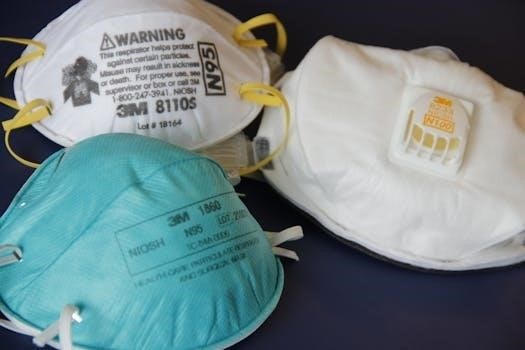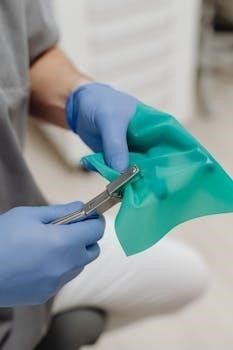
-
By:
- ophelia
- No comment
surgical positions pdf
Surgical Positioning⁚ An Overview
Proper surgical positioning is a cornerstone of safe and successful surgery. It ensures optimal exposure of the operative site.
Maintaining the patient’s physiological well-being is paramount. Perioperative teams collaborate to plan and execute safe positioning.
Positions like supine, prone, and lateral are common. Each presents unique considerations for patient safety and surgical access.
Definition of Ideal Surgical Position
The ideal surgical position is defined as one that provides optimal access to the anatomical target while ensuring the anesthetized patient can tolerate the positional changes both structurally and physiologically. This means the position allows the surgeon to clearly visualize and operate on the intended area with ease and precision. The selected position must also consider the patient’s physical limitations and overall health, preventing undue stress or injury. The goal is to balance surgical access with patient safety, minimizing the risk of nerve damage, pressure ulcers, or respiratory compromise. Anesthesia considerations are key, as the patient’s ability to compensate for positional changes is diminished.

Importance of Proper Surgical Positioning
Proper surgical positioning is essential for both optimal surgical access and patient safety during procedures.
Optimal Surgical Access
Achieving optimal surgical access is a primary goal of proper patient positioning. This involves carefully arranging the patient on the operating table to provide the surgeon with the best possible view of, and reach to, the surgical site. The chosen position should allow for adequate exposure of the anatomical target, enabling the surgeon to perform the procedure with precision and efficiency. Factors such as the location of the incision, the depth of the surgical field, and the need for specific angles of approach all influence the selection of the most appropriate position. Moreover, the positioning should facilitate the use of surgical equipment, such as C-arms, operating microscopes, lasers, or surgical robots, ensuring that these tools can be easily and effectively deployed during the operation. Ultimately, optimal surgical access contributes to a smoother, more efficient surgical process, potentially reducing operative time and improving patient outcomes.
Patient Safety and Comfort
Ensuring patient safety and comfort is an equally critical aspect of surgical positioning. While providing optimal surgical access is essential, it must be balanced with the need to protect the patient from potential harm. Anesthetized patients are unable to communicate discomfort or reposition themselves, making them vulnerable to positioning-related injuries. Therefore, careful consideration must be given to maintaining proper alignment, preventing excessive pressure on bony prominences, and avoiding nerve compression. Padding and support devices are crucial tools for minimizing pressure points and ensuring adequate circulation. The perioperative team plays a vital role in continuously monitoring the patient’s position and making adjustments as needed to prevent complications such as pressure ulcers or nerve damage. Furthermore, preserving the patient’s dignity by preventing unnecessary exposure is also a key responsibility. Ultimately, prioritizing patient safety and comfort contributes to a positive surgical experience and reduces the risk of adverse outcomes.

Common Surgical Positions
Several standard surgical positions are employed, each tailored to specific surgical needs and anatomical access.
These include supine, prone, lateral, lithotomy and variations.
Understanding the nuances of each position is crucial for optimal surgical outcomes.
Supine Position
The supine position is one of the most frequently used positions in surgery, especially for abdominal procedures. In this position, the patient lies on their back with their face upward. It is ideal for accessing the peritoneal cavity, making it a common choice for operations like exploratory laparotomies, bowel resections, cholecystectomies, and appendectomies. The supine position is versatile and used in both laparoscopic and open surgeries, although slight adjustments in patient positioning may be necessary depending on the specific technique. Perioperative personnel must carefully consider patient safety and comfort due to the increased pressure on areas like the back of the head, elbows, scapulae, sacrum, coccyx, and heels.
Prone Position
The prone position requires the patient to lie on their abdomen with the face turned to the side, ensuring that the airway remains unobstructed. This position is commonly used for surgical procedures involving the spine, posterior skull, and certain lower extremity operations. Proper padding and support are crucial to minimize pressure on bony prominences, such as the anterior iliac spines, knees, and ankles. Special attention must be given to protecting the patient’s eyes and ears to prevent corneal abrasions or nerve damage. The prone position can compromise respiratory function due to abdominal compression, so monitoring ventilation is essential. Careful coordination among the surgical team is needed to safely turn and position the anesthetized patient, ensuring alignment and preventing injury.
Lateral Position
In the lateral position, the patient lies on their side, either left or right, depending on the surgical site. This position is frequently used for procedures involving the kidney, hip, chest, or shoulder. Proper alignment and support are vital to prevent nerve damage and pressure ulcers. The dependent arm is typically placed on a padded arm board, while the upper arm is supported with pillows or an adjustable arm holder. A beanbag or other positioning device may be used to stabilize the patient and maintain the lateral position throughout the procedure. Respiratory function can be affected due to compression of the dependent lung, so monitoring is crucial. Pressure points, such as the iliac crest, greater trochanter, and ankles, require careful padding. The surgical team must work together to ensure the patient is safely positioned and any potential risks are minimized. Special considerations should be given to patients with pre-existing respiratory or cardiovascular conditions.

Factors Affecting Surgical Positioning
Several factors influence surgical positioning, including procedure type, duration, and patient health status.
These considerations are crucial for safety.
Type and Length of Surgical Procedure
The surgical procedure’s nature dictates positioning needs. Abdominal surgeries commonly utilize the supine position for optimal access. Conversely, posterior fossa surgeries may require a modified lateral or semi-prone position.
The length of the procedure significantly impacts positioning decisions. Prolonged surgeries increase the risk of complications like pressure ulcers and nerve damage. Therefore, meticulous padding and frequent position adjustments are crucial for longer cases.
For instance, robotic procedures, which can be lengthy, necessitate careful consideration of patient positioning. Some experts recommend a second “time out” during long robotic surgeries to reassess the patient’s position and address any safety concerns arising from prolonged immobility. This involves verifying proper equipment functioning and documenting specific patient care measures taken to mitigate risks associated with extended surgical duration.
Ultimately, the surgical team must balance optimal surgical access with minimizing patient risk, taking into account both the type and expected length of the procedure.
Patient’s Condition
A patient’s pre-existing conditions significantly influence surgical positioning strategies. Factors such as age, weight, nutritional status, and mobility level all play crucial roles; Elderly patients, for example, may have decreased skin integrity and increased susceptibility to pressure ulcers, requiring extra padding and careful positioning.
Patients with compromised respiratory function require positions that optimize ventilation. The supine position, while common, can compromise respiration by allowing abdominal viscera to shift upward toward the diaphragm, decreasing tidal volume. Careful monitoring and adjustments are necessary.
Hemodynamic stability is another critical consideration. Certain positions, like Trendelenburg, can impact blood pressure and venous return. Patients with cardiovascular issues require close monitoring and potential adjustments to positioning to maintain adequate perfusion.
Preoperative assessment of the patient’s physical limitations and vulnerabilities is essential. Collaboration between the surgeon, anesthesiologist, and perioperative nurses ensures that the chosen position accommodates the patient’s specific needs and minimizes the risk of complications. This collaborative approach helps balance surgical access with patient safety and comfort, leading to better outcomes.

Potential Complications and Injuries
Surgical positioning carries inherent risks. Nerve damage and pressure ulcers are among the most common complications.
Improper technique can lead to injuries. Vigilance and proper padding are crucial for prevention and safety.
Nerve Damage
Nerve damage is a significant risk associated with surgical positioning. Various factors contribute to this potential complication, including prolonged pressure, stretching, or direct compression of nerves during the procedure. Certain surgical positions, particularly those involving extreme flexion, extension, or abduction of limbs, can exacerbate the risk. Careful attention to anatomical landmarks, proper padding and support, and vigilant monitoring throughout the surgery are essential for preventing nerve-related injuries. Collaboration between the surgical team, anesthesiologist, and perioperative nurses is crucial to identify and mitigate potential risk factors. Documenting positions and conducting safety checks helps ensure patient safety protocols are followed. Addressing patient-specific concerns and adjusting positioning as needed can further minimize the likelihood of nerve damage during surgery.
Pressure Ulcers
Pressure ulcers, also known as bedsores or pressure injuries, represent another significant complication associated with surgical positioning. These localized injuries to the skin and underlying tissue typically occur over bony prominences due to sustained pressure, shear forces, or friction. The risk of pressure ulcer development is heightened during lengthy surgical procedures, particularly in patients with compromised circulation, malnutrition, or limited mobility. Careful assessment of the patient’s skin integrity, proper padding and support of vulnerable areas, and frequent repositioning are crucial preventive measures. Utilizing pressure-redistributing mattresses, cushions, and specialized support surfaces can further reduce the risk. Close monitoring of pressure points, documentation of positioning interventions, and prompt management of any skin changes are essential components of comprehensive pressure ulcer prevention strategies in the perioperative setting. Collaboration among all members of the surgical team is key to minimizing the incidence of these potentially debilitating complications.
Responsibilities in Surgical Positioning
Surgical positioning is a collaborative effort. Surgeons, anesthesiologists, and nurses share vital responsibilities.
Effective communication and teamwork are crucial for patient safety. Everyone must understand their role.
Proper planning, execution, and documentation are essential. This ensures optimal patient outcomes and reduces risk.
Surgeon and Anesthesiologist Collaboration
The surgeon and anesthesiologist play pivotal roles in surgical positioning. Their collaboration is paramount for patient safety and optimal surgical access. The surgeon defines the required surgical site exposure, considering the specific needs of the procedure. Concurrently, the anesthesiologist assesses the patient’s physiological status, taking into account pre-existing conditions and potential risks associated with different positions. Together, they determine the most appropriate position that balances surgical needs with the patient’s ability to tolerate the position structurally and physiologically. They also work together to promote the patient’s access to medications, fluids, blood, and blood products.
This collaborative process involves a thorough pre-operative assessment and discussion. The surgeon explains the necessary position and its rationale, while the anesthesiologist evaluates the patient’s cardiovascular, respiratory, and neurological systems. They consider factors such as the patient’s age, weight, body habitus, and any existing limitations. This joint evaluation ensures that the chosen position does not compromise the patient’s breathing, circulation, or nerve function. Furthermore, they work in tandem to position surgical equipment for the surgical team to use with ease. Throughout the procedure, both monitor the patient’s response to the positioning, making adjustments as needed to maintain stability and prevent complications.
Perioperative Nursing Responsibilities
Perioperative nurses are integral to safe surgical positioning. They actively participate in the planning and execution, ensuring patient safety and comfort. Their responsibilities begin with a thorough pre-operative assessment, identifying patient-specific risk factors like pressure points or pre-existing conditions. Nurses collaborate with the surgical team to develop a positioning plan that minimizes these risks while optimizing surgical access. They ensure proper padding and support devices are used to protect vulnerable areas. Furthermore, the perioperative nurse is responsible for promoting patient dignity by preventing unnecessary exposure.
During positioning, nurses meticulously monitor the patient’s skin integrity and circulation. They are vigilant for signs of nerve compression or pressure ulcer development. They also ensure proper alignment and prevent hyperextension of joints. The nurse is also responsible for the safe and effective transfer and positioning. They document the patient’s position and any specific care provided. Post-operatively, nurses continue to assess for any positioning-related complications. They evaluate the outcomes of patient positioning, looking for signs of nerve damage or skin breakdown. Their vigilant monitoring and proactive interventions are crucial in preventing adverse events and promoting patient well-being throughout the perioperative period.
Equipment and Tools for Positioning
OR tables are central, offering adjustability for various positions. Padding and supports protect pressure points.
Specialized equipment like arm boards and stirrups aid in specific positions.
Proper selection and use are crucial for patient safety.